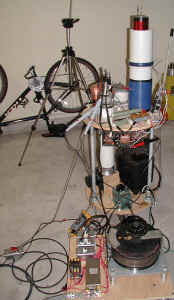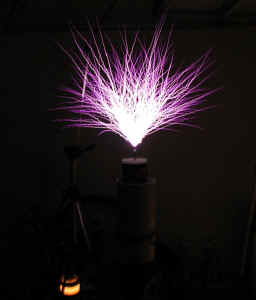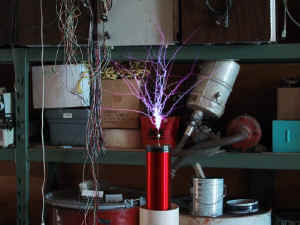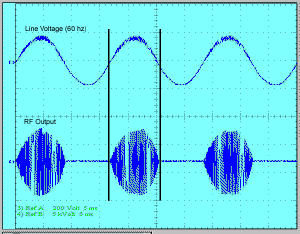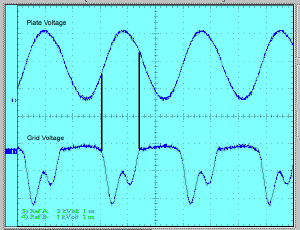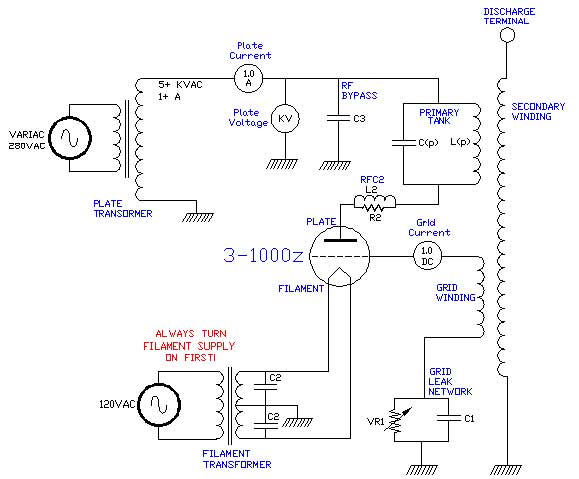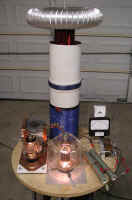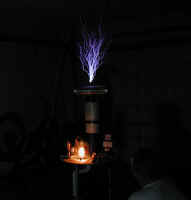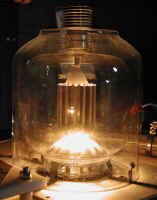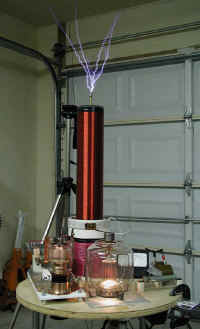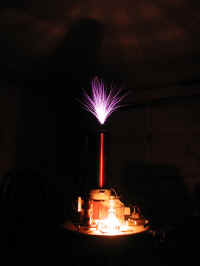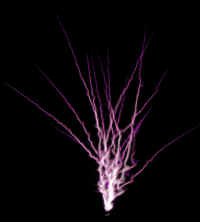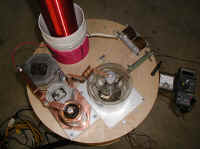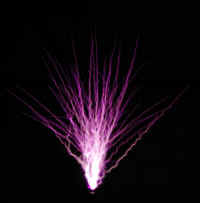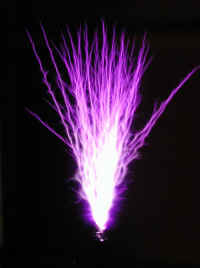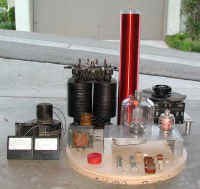12/25/00 - 1/13/00
Started working on tube coil
in the Austin, TX lab.
- Secondary 4" OD plexi,
0.021" magnet wire, 23 5/16" of windings,
measured w/ Wavetek 27XT: R=18.5 ohms, L (measured) =18.34 mH,
L(Wheeler)=19.6 mH, F(r) Wheeler&Medhurst = 376 kHz
F(r)= 410 kHz, measured in garage, ~6' to walls, ~4' to ceiling,
mounted on
stand w/ plate xformer ~1' below, bare tube socket in place,
primary former removed. F(r) = 404 kHz with tube, globe, 1
mica tank cap, and vacuum variable cap sitting on top of platform.
- Primary
6 5/16" SDR PVC, 32T, 12 GA Stranded THHN
I have 1.27 nF of tank capacitance with the Jennings in the
half-way position in parallel with the 2 Mica capacitors. According to the Wheeler formula, I need about
31.5 turns of L(p) to force the resonant freq of the primary to equal
that of the secondary.
Again, L was verified by paralleling the primary with a known
C and checking F(r).
C = 0.57nF, F(r) meas = 550kHz, therefore L = 147 uH, L (Wheeler) = 145 uH.
Coupling Test on the 32T primary and existing secondary. I
(primary) = 6.83 A, V (secondary) = 1.11 V, therefore K =0.263.
Note: I couldn't find the recommended 1uF
capacitor recommended in the coupling procedure so I used a 0.1uF instead.
---Original Primary design (25T) is
shown in green txt---
6 5/16" SDR PVC,
25T, 12 GA Stranded THHN, 3 7/16" across 24T
L is was low to be measured with my meter so I added a known
capacitance in parallel and measured the resonant freq. (
Wheeler formula estimates 102 uH )
0.57 nF = 654 kHz, therefore L(p) = 104 uH
2.36 nF = 328 kHz, therefore L(p) = 100 uH <<
this means that I can trust Wheeler formula for L(p) >>
- Grid Winding 10T + 8T, 16 GA
PVC, about 1.25" across windings
R1 advice from Simon Winder. "
I recommend putting a 50 ohm 3W carbon fim resistor in series with the
grid, soldered as close as possible to the grid terminal. This helps
reduce parasitic oscillations because it acts as a low pass filter
with the tube grid capacitance."
- Grid Leak Network
VR1: 7.5
Kohm, 100W. C1:
3.56nF. I used (2) Sprauge 2500MMFD, 30KV, 399A259 doorknob caps so
I expected about 5 nF. I checked the battery in the meter and
checked the meter against several other caps of a known value and it
checks out fine. Maybe these large doorknobs decrease in capacitance
over time or hours of useage???
- Tank Capacitors C(p)
- used 3 capacitors in parallel
- Jennings Vacuum Variable Type UCS, 10KV, Number on
base is N16-C-65869-204, measures 0 - 0.450 nF
- Sangamo Mica, 0.57 nF, 10 KV
- Sangamo Mica, 0.50 nF, 20 KV
- Filament Suppy and RF
protection
The filament will be heated with the original 7.5V, 22A filament
transformer. I am straying from typical amplifier design in that
I'm choosing not to ground the center tap and I will ground one side
of the transformer instead. The center tap is grounded in RF
amplifers to limit "hum" modulation. I don't have to
worry about hum and can significantly reduce component count by
grounding one side of the transformer.
RFC1 and C1 are most likely not needed, but I included them in the
circuit since they were on hand. C1 = Sangamo 0.033 MFD, 1200VDCW, 2500VDC test, Mica
capacitor. RFC1 is about 12T of ~10ga magnet wire bifilar wound on a 6" long by 1/2" diameter ferrite rod.
- RF Bypass between
tank and Plate PSU
C3: MMC design. About 10nF of series/parallel
metalized PP capacitors of the same type I used in my disruptive tesla
coil MMC. See my MMC page.
- RF Choke on the plate
The following was copied from page 13.25 of the 1998 ARRL
Handbook. "Nearly all vacuum-tube amplifiers designed for
operation in the 1.8 to 27.9 MHz freq range tend to oscillate
somewhere in the VHF-UHF range - generally between 75 and 250 MHz
depending on the type and size of the tube....Stray inductance between
the tube plate and output tuning capacitor forms a high-Q resonant
circuit with the tube's C(out)" The article goes on to show
schematics and formulas to help understand how the high freq
oscillations come about. It suggests that tubes such and 3-500z
may require around 3-5 turns of #10 wire wound 0.25-0.50" in
diameter and about 0.5-1.0 inches long. It suggest that the
parallel resistance be about 50 ohms at 2 watts. Luckily, I
saved the choke that the original amplifier builder used
|
